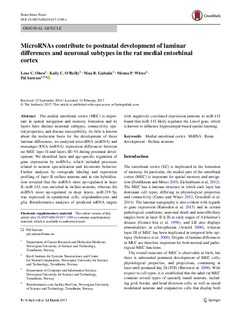| dc.contributor.author | Olsen, Lene Christin | |
| dc.contributor.author | O'Reilly, Kally | |
| dc.contributor.author | Liabakk, Nina-Beate | |
| dc.contributor.author | Witter, Menno | |
| dc.contributor.author | Sætrom, Pål | |
| dc.date.accessioned | 2017-12-13T12:37:15Z | |
| dc.date.available | 2017-12-13T12:37:15Z | |
| dc.date.created | 2017-03-21T11:51:29Z | |
| dc.date.issued | 2017 | |
| dc.identifier.citation | Brain Structure and Function. 2017, 222 (7), 3107-3126. | nb_NO |
| dc.identifier.issn | 1863-2653 | |
| dc.identifier.uri | http://hdl.handle.net/11250/2471184 | |
| dc.description.abstract | The medial entorhinal cortex (MEC) is important in spatial navigation and memory formation and its layers have distinct neuronal subtypes, connectivity, spatial properties, and disease susceptibility. As little is known about the molecular basis for the development of these laminar differences, we analyzed microRNA (miRNA) and messenger RNA (mRNA) expression differences between rat MEC layer II and layers III–VI during postnatal development. We identified layer and age-specific regulation of gene expression by miRNAs, which included processes related to neuron specialization and locomotor behavior. Further analyses by retrograde labeling and expression profiling of layer II stellate neurons and in situ hybridization revealed that the miRNA most up-regulated in layer II, miR-143, was enriched in stellate neurons, whereas the miRNA most up-regulated in deep layers, miR-219-5p, was expressed in ependymal cells, oligodendrocytes and glia. Bioinformatics analyses of predicted mRNA targets with negatively correlated expression patterns to miR-143 found that miR-143 likely regulates the Lmo4 gene, which is known to influence hippocampal-based spatial learning. | nb_NO |
| dc.language.iso | eng | nb_NO |
| dc.publisher | Springer Verlag | nb_NO |
| dc.rights | Navngivelse 4.0 Internasjonal | * |
| dc.rights.uri | http://creativecommons.org/licenses/by/4.0/deed.no | * |
| dc.title | MicroRNAs contribute to postnatal development of laminar differences and neuronal subtypes in the rat medial entorhinal cortex | nb_NO |
| dc.type | Journal article | nb_NO |
| dc.type | Peer reviewed | nb_NO |
| dc.description.version | publishedVersion | nb_NO |
| dc.source.pagenumber | 3107–3126 | nb_NO |
| dc.source.volume | 222 | nb_NO |
| dc.source.journal | Brain Structure and Function | nb_NO |
| dc.source.issue | 7 | nb_NO |
| dc.identifier.doi | 10.1007/s00429-017-1389-z | |
| dc.identifier.cristin | 1459973 | |
| dc.description.localcode | © The Author(s) 2017. Open Access. This article is distributed under the terms of the Creative Commons Attribution 4.0 International License (http://creativecommons.org/licenses/by/4.0/), which permits unrestricted use, distribution, and reproduction in any medium, provided you give appropriate credit to the original author(s) and the source, provide a link to the Creative Commons license, and indicate if changes were made. | nb_NO |
| cristin.unitcode | 194,65,15,0 | |
| cristin.unitcode | 194,65,60,0 | |
| cristin.unitcode | 194,63,10,0 | |
| cristin.unitname | Institutt for klinisk og molekylær medisin | |
| cristin.unitname | Kavliinstitutt for nevrovitenskap | |
| cristin.unitname | Institutt for datateknologi og informatikk | |
| cristin.ispublished | true | |
| cristin.fulltext | postprint | |
| cristin.qualitycode | 2 | |

